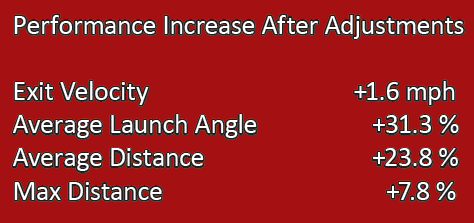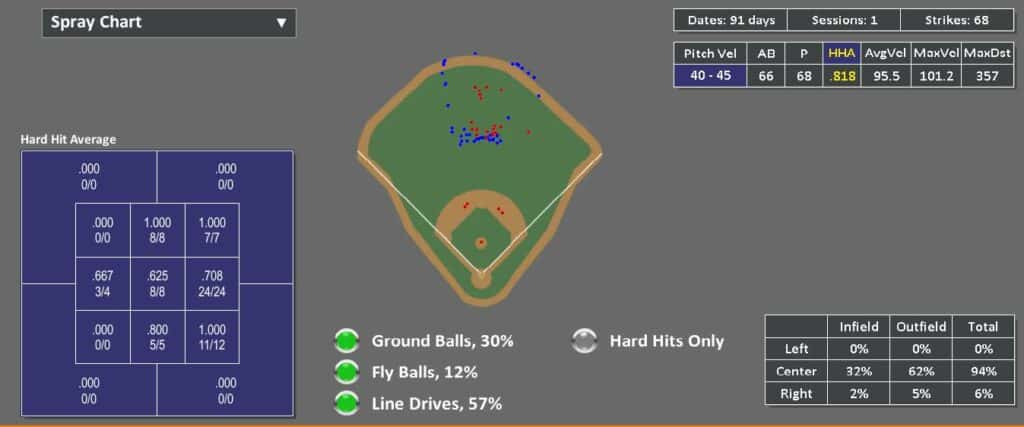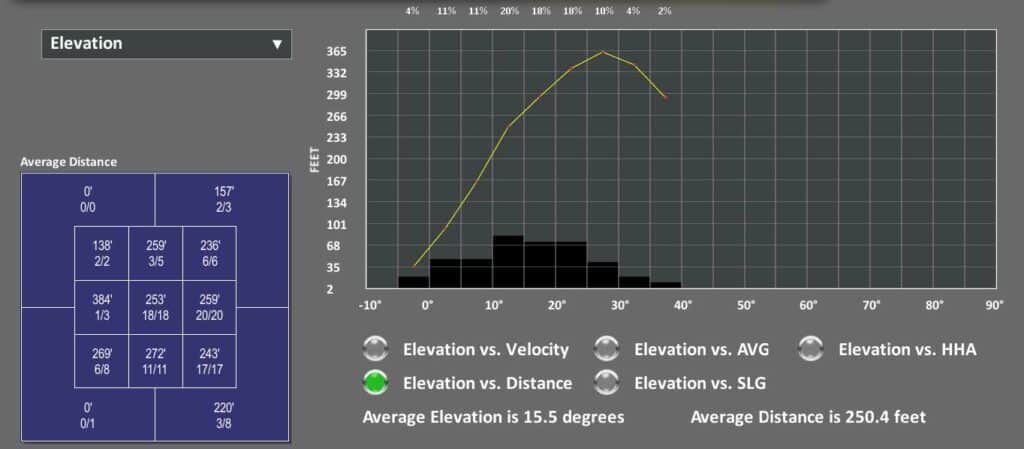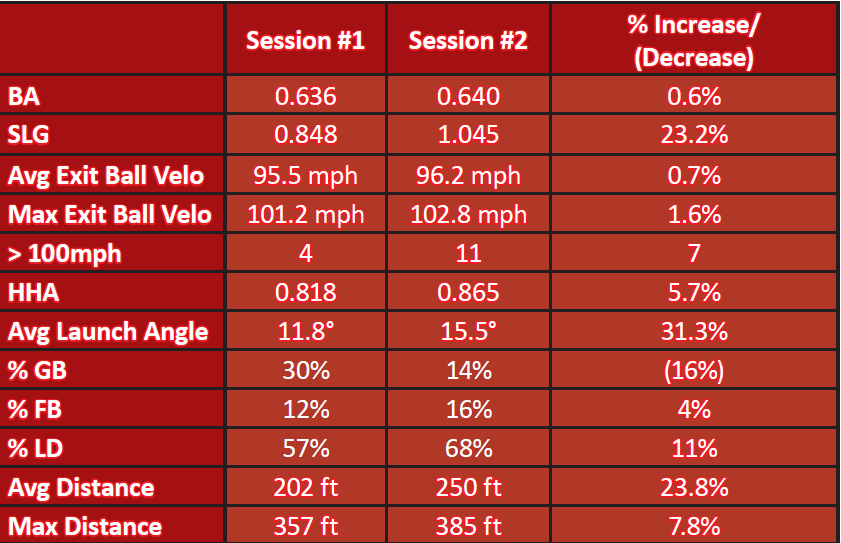Matt R, a RH hitting middle infielder with a National League organization, is a self-proclaimed line drive hitter that can “hit an occasional home run off of a curve ball.” He solicited assistance from Rick Strickland of Elite Baseball Training in Bridgeton, MO to increase his torque rotation through the swing, which will increase bat speed, and ultimately, gain distance with his hits.

First Batting Session Assessment
After three days of workouts at the facility, the HitTrax™ Data Capture and Simulation System was used during Matt’s hitting sessions to capture a baseline for specific metrics such as exit velocity, launch angle and projected distance. The session consisted of front toss at roughly 30ft in front of home plate with an average pitch speed of 43 mph.
The following statistics were captured:

The average exit ball velocity during the session was 95.5 mph with the maximum exit velo coming in at 101.2 mph. Of the 66 hits, four exceeded 100 mph. The Hard Hit Average (HHA), or percentage of hits that were 90% and above his maximum exit ball velocity, was .818. The average launch angle during the entire session was 11.6 degrees, which translated to an average distance of 202ft. The longest hit was projected to reach 357ft.
Using the advanced HitTrax algorithms to calculate the likely results against a professional level defense, the stats translate to a Batting Average (BA) of .636 and a SLG percentage of .848. Below are elevation charts that break down the hits into launch angles of 5 degree increments. The averages for exit velocity and distances for all hits within the corresponding increments are then plotted on the x and y axis, respectively.


Reviewing the LA vs. Avg Exit Velo chart, it is apparent that Matt has a level to slightly downward swing as his exit velo peaks in the -5 to -10 degree increment at 98 mph. The exit velo then decreases slightly to 96-97 mph until the 20 degree angle is reached where it then falls off to the low 90’s.
The LA vs. Distance chart shows that the average distance peaks at 350ft when the LA is within the 25° and 30° increment.
The LA vs. BA and SLG percentages are shown in the chart below. It should be noted that both percentages dip significantly when the LA reaches the 15°-20° increment and then again in the 25°-30° increment. By knowing that the average distances for these two increments are 280ft and 350ft, respectively, and reviewing the below spray chart, which indicates that 94% of the balls struck were directed towards centerfield, it can be interpreted that these hits did not have enough distance nor were they hit in a direction that would elude the centerfielder.


Adjustments
The data from the first session indicated that Coach Strickland needed to elevate Matt’s swing plane so that his exit ball velocity peaks in the 0 to 10 degree range, rather than the -5 to -10 degree increment. With this goal now known, Coach Strickland designed a series of exercises to increase the lift in the swing, which Matt implemented in the next series of batting sessions.
Second Batting Session Assessment
Utilizing the adjustments, Matt stepped back into the HitTrax cage and recorded a second session.
Results were as follows:

Reviewing the stats, the second session produced a measurable increase in key metrics compared to the first session. The maximum exit ball velocity recorded for this session was 102.8 mph compared to 101.2 mph in the first session. The average exit velocity increased as well from 95.5 mph to 96.2 mph. Of the 89 hits, eleven exceeded 100 mph and his HHA increased to 0.865 from 0.818.
Looking to add more lift to the swing and distance in his hits, Matt increased his overall average launch angle to 15.5° in this session from the previous average of 11.8°. This produced a significant increase in his average distance for the session at 250ft against 202ft for the first session. The longest drive was calculated at 385 ft compared to 357 ft in the first.


The above LA vs. Exit Ball Velocity chart indicates notable increases in the 0°-5° and 5°-10° increments from 96mph to 99mph in the second session. The 25°-30° increment, which is the LA that will produce longer drives, also showed a significant increase in velocity from 92mph in the first session to 95mph in the second.
Reviewing the LA vs. Average Distance chart, it should be noted that the average distance in the 25°-30° increment increased by 10ft.
While his BA remained basically the same at 0.640, the added velocity and distance significantly increased his overall SLG percentage from 0.848 to 1.045. It should be noted, however, that the below spray chart clearly shows that Matt used a great deal more of the field in the second session.


As stated, there was a significant increase in overall SLG from the first session, however, the added lift in Matt’s swing increased the average exit velocity by 3 mph (from 92mph to 95mph) within the crucial 25°-30° increment. This translated to a dramatic increase in SLG for this increment from 0.000 in the first session to 1.800 in the second session. The total number of hits launched in the 25°-30° increment increased from a total of 4 in the first session to 11 in the second.
Lastly, the spray chart shows that the percentage of ground balls drastically decreased from 30% in the first session to 14% in the second session while both the percentage of fly balls and line drives increased.
Results
The data collected by the HitTrax System during the first session was instrumental in isolating the areas of Matt’s swing that needed improvement. With this information now known, Coach Strickland was able to implement a new foot stride that forced Matt to elevate his swing plane through contact.
Rather than a subjective impression of improvement, HitTrax was able to measure quantifiable gain in exit ball velocity and launch angle using the new stride. While the average exit ball velocity increased slightly (~1%) over the baseline session, the new stride produced a significant gain in the launch angle as the average increased by 31% in the second session. The higher exit velocities, coupled with the increased launch angle, produced a substantial boost in distance with the average for the session increasing by 48ft and the longest drive by 28 ft.
The following is a summary of the gains for each measured metric and calculated statistic and/or distance:

While we recognize the fact that this data represents a comparison between two specific batting sessions before and after the adjustment, it should be noted that additional batting sessions were recorded prior to and after the new stride was implemented. In all instances, similar gains were measured for exit velocities, launch angles and projected distances.


